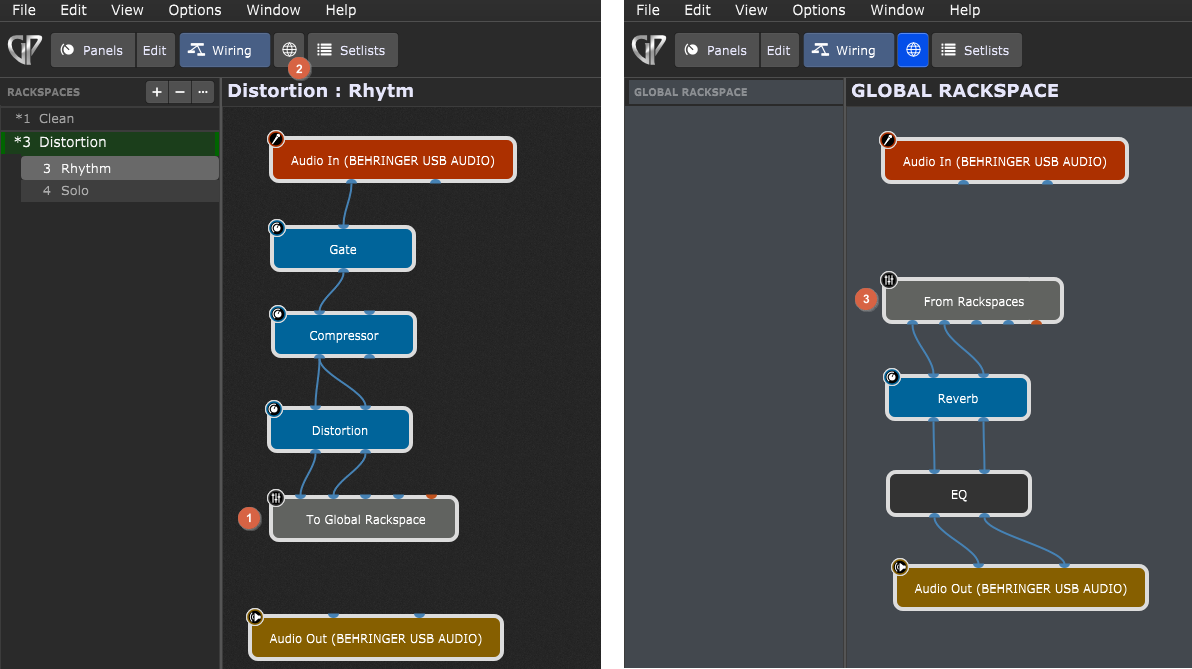The Global rackspace is a special rackspace that allows audio plugins to be shared and used by normal rackspaces (from now on, these will just be called "rackspaces"). The Global rackspace is always active. For example, you can create global effects - e.g. a common reverb, delay, or chorus, instead of creating them in individual rackspaces. Audio and MIDI from the currently active rackspace can then be sent to the Global rackspace for processing. You can of course also insert regular synth plugins along with MIDI In blocks to the Global rackspace. This would allow you to, for example, have a piano or organ that is always available.
The Global rackspace is bidirectional. That means that while audio and MIDI can be sent from rackspaces to the Global rackspace (to support common effects as described above), audio and MIDI can also be sent from the Global rackspace back to whatever rackspace is currently active. This is particularly valuable for guitarists or singers who may want to always add a certain amount of "pre-processing" to their input, for example.
Below is an example of a rackspace and the Global rackspace working together:

The signal flow is easy to understand; note the special block called To Global Rackspace (1) in the left screenshot, where signals are directed to the Global rackspace instead of being sent to the Audio Out block. The Global rackspace can be accessed by clicking on the globe icon (2).
In the right screenshot, the Global rackspace wiring layout can be seen. Note the special block From Rackspaces (3), used to receive audio (and MIDI) sent from rackspaces to be further processed serially through the Reverb and EQ blocks before being sent to the Audio Out.
When the Clean rackspace is active (in which no distortion or compressor plugins are in use), the signal flow is still ultimately directed to the Global rackspace and further processed by Reverb and EQ and so there is no need to include effects such as reverb or delay in every rackspace.
To conclude, while the Global rackspace can be used for many purposes, the three primary uses are:
•Master effects processing - allows you to send a signal from any rackspace to the Global rackspace where you can add effects, EQ, and other plugins for further signal processing. In previous Gig Performer editions, you must insert and connect all these effects in every rackspace if you want to use them; in Gig Performer, you can insert these effects into the Global rackspace and send signals from the active rackspace to the Global rackspace and thereby saving a lot of plugin duplication that was necessary in older versions (Gig Performer 3 and older).
•Input pre-processing - the Global Rackspace receives audio and MIDI input from your instrument, does some common pre-processing and sends the result to the active rackspace for specific effects needed for individual songs.
•Permanent instrument patch - allows you to add an instrument patch (e.g. a standard piano patch) that is always available from any rackspace. You can also create (say) a permanent vocal setup in the Global rackspace and just use rackspaces for your guitar, piano or other instrument layouts.
Tip: check The Main Gig Performer window chapter, point 21, to learn how to show/hide the Global rackspace controls when regular rackspaces are displayed.
Further reading:
![]() Rackspaces and Variations
Rackspaces and Variations
![]() Built-in plugins
Built-in plugins